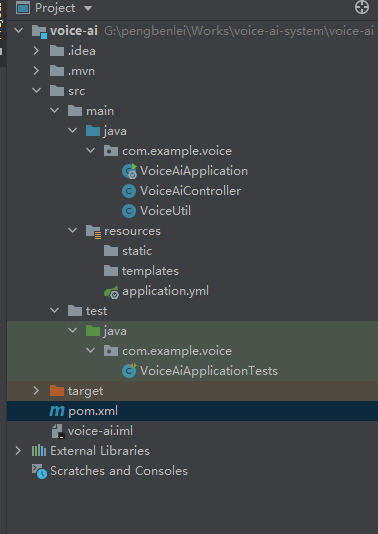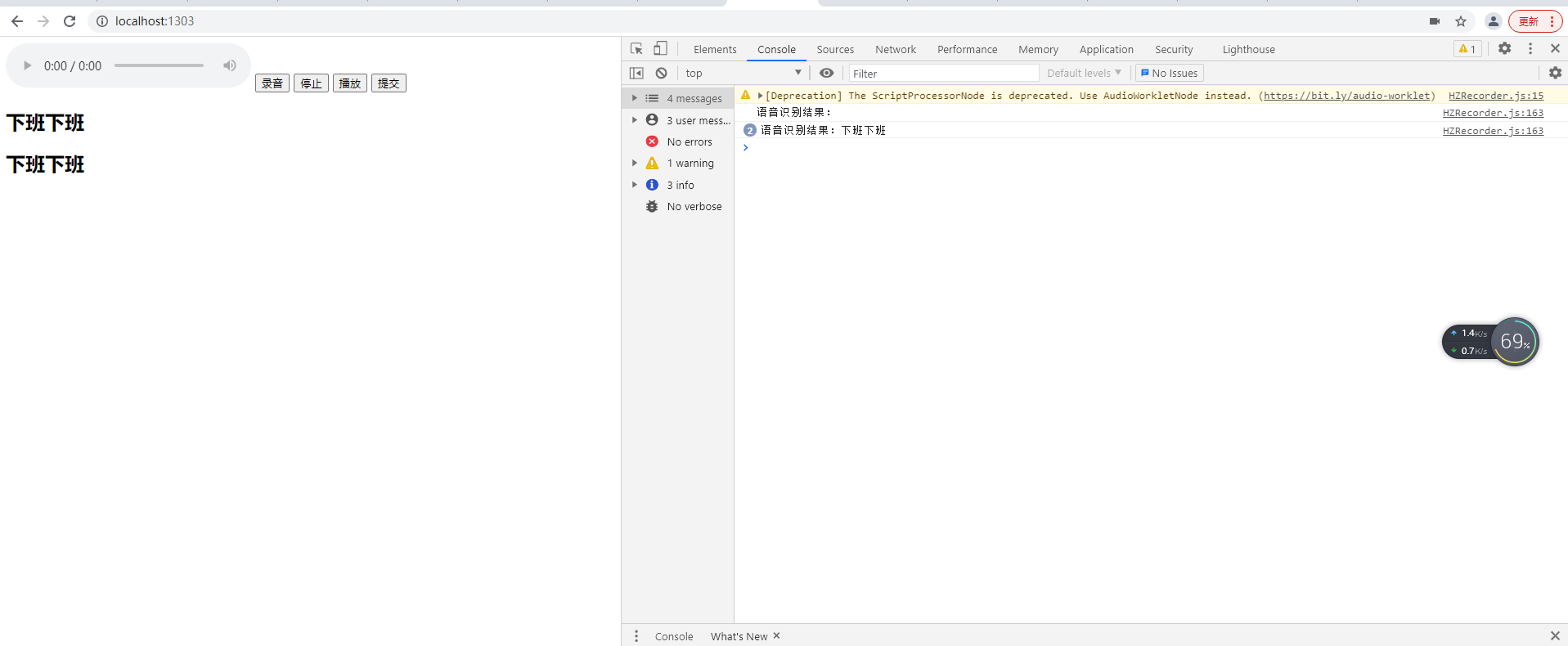Java离线中文语音文字识别功能怎么实现
短信预约 -IT技能 免费直播动态提醒
这篇文章主要讲解了“Java离线中文语音文字识别功能怎么实现”,文中的讲解内容简单清晰,易于学习与理解,下面请大家跟着小编的思路慢慢深入,一起来研究和学习“Java离线中文语音文字识别功能怎么实现”吧!
1、pom文件如下:
<?xml version="1.0" encoding="UTF-8"?><project xmlns="http://maven.apache.org/POM/4.0.0" xmlns:xsi="http://www.w3.org/2001/XMLSchema-instance" xsi:schemaLocation="http://maven.apache.org/POM/4.0.0 https://maven.apache.org/xsd/maven-4.0.0.xsd"> <modelVersion>4.0.0</modelVersion> <parent> <groupId>org.springframework.boot</groupId> <artifactId>spring-boot-starter-parent</artifactId> <version>2.5.4</version> <relativePath/> <!-- lookup parent from repository --> </parent> <groupId>com.example</groupId> <artifactId>voice</artifactId> <version>0.0.1-SNAPSHOT</version> <name>voice-ai</name> <description>Demo project for Spring Boot</description> <properties> <java.version>1.8</java.version> </properties> <repositories> <repository> <id>com.alphacephei</id> <name>vosk</name> <url>https://alphacephei.com/maven/</url> </repository> </repositories> <dependencies> <dependency> <groupId>org.springframework.boot</groupId> <artifactId>spring-boot-starter-web</artifactId> </dependency> <dependency> <groupId>org.springframework.boot</groupId> <artifactId>spring-boot-starter-test</artifactId> <scope>test</scope> </dependency> <dependency> <groupId>net.java.dev.jna</groupId> <artifactId>jna</artifactId> <version>5.7.0</version> </dependency> <dependency> <groupId>com.alphacephei</groupId> <artifactId>vosk</artifactId> <version>0.3.30</version> </dependency> <dependency> <groupId>org.projectlombok</groupId> <artifactId>lombok</artifactId> <optional>true</optional> </dependency> <dependency> <groupId>com.alibaba</groupId> <artifactId>fastjson</artifactId> <version>1.2.8</version> </dependency> </dependencies> <build> <plugins> <plugin> <groupId>org.springframework.boot</groupId> <artifactId>spring-boot-maven-plugin</artifactId> </plugin> </plugins> </build></project>特别说明一下,vosk的包在常见的maven仓库里面是没有的,所以需要指定下载地址。
2、工程结构:

3、语音识别工具类
public class VoiceUtil { @Value("${leenleda.vosk.model}") private String VOSKMODELPATH; public String getWord(String filePath) throws IOException, UnsupportedAudioFileException { Assert.isTrue(StringUtils.hasLength(VOSKMODELPATH), "无效的VOS模块!"); byte[] bytes = Files.readAllBytes(Paths.get(filePath)); // 转换为16KHZ reSamplingAndSave(bytes, filePath); File f = new File(filePath); RandomAccessFile rdf = null; rdf = new RandomAccessFile(f, "r"); log.info("声音尺寸:{}", toInt(read(rdf, 4, 4))); log.info("音频格式:{}", toShort(read(rdf, 20, 2))); short track=toShort(read(rdf, 22, 2)); log.info("1 单声道 2 双声道: {}", track); log.info("采样率、音频采样级别 16000 = 16KHz: {}", toInt(read(rdf, 24, 4))); log.info("每秒波形的数据量:{}", toShort(read(rdf, 22, 2))); log.info("采样帧的大小:{}", toShort(read(rdf, 32, 2))); log.info("采样位数:{}", toShort(read(rdf, 34, 2))); rdf.close(); LibVosk.setLogLevel(LogLevel.WARNINGS); try (Model model = new Model(VOSKMODELPATH); InputStream ais = AudioSystem.getAudioInputStream(new BufferedInputStream(new FileInputStream(filePath))); // 采样率为音频采样率的声道倍数 Recognizer recognizer = new Recognizer(model, 16000*track)) { int nbytes; byte[] b = new byte[4096]; int i = 0; while ((nbytes = ais.read(b)) >= 0) { i += 1; if (recognizer.acceptWaveForm(b, nbytes)) {// System.out.println(recognizer.getResult()); } else {// System.out.println(recognizer.getPartialResult()); } } String result = recognizer.getFinalResult(); log.info("识别结果:{}", result); if (StringUtils.hasLength(result)) { JSONObject jsonObject = JSON.parseObject(result); return jsonObject.getString("text").replace(" ", ""); } return ""; } } public static int toInt(byte[] b) { return (((b[3] & 0xff) << 24) + ((b[2] & 0xff) << 16) + ((b[1] & 0xff) << 8) + ((b[0] & 0xff) << 0)); } public static short toShort(byte[] b) { return (short) ((b[1] << 8) + (b[0] << 0)); } public static byte[] read(RandomAccessFile rdf, int pos, int length) throws IOException { rdf.seek(pos); byte result[] = new byte[length]; for (int i = 0; i < length; i++) { result[i] = rdf.readByte(); } return result; } public static void reSamplingAndSave(byte[] data, String path) throws IOException, UnsupportedAudioFileException { WaveFileReader reader = new WaveFileReader(); AudioInputStream audioIn = reader.getAudioInputStream(new ByteArrayInputStream(data)); AudioFormat class="lazy" data-srcFormat = audioIn.getFormat(); int targetSampleRate = 16000; AudioFormat dstFormat = new AudioFormat(class="lazy" data-srcFormat.getEncoding(), targetSampleRate, class="lazy" data-srcFormat.getSampleSizeInBits(), class="lazy" data-srcFormat.getChannels(), class="lazy" data-srcFormat.getFrameSize(), class="lazy" data-srcFormat.getFrameRate(), class="lazy" data-srcFormat.isBigEndian()); AudioInputStream convertedIn = AudioSystem.getAudioInputStream(dstFormat, audioIn); File file = new File(path); WaveFileWriter writer = new WaveFileWriter(); writer.write(convertedIn, AudioFileFormat.Type.WAVE, file); }}有几点需要说明一下,官方demo里面对采集率是写死了的,为16000。这是以16KHz来算的,所以我把所有拿到的音频都转成了16KHz。还有采集率的设置,需要设置为声道数的倍数。
4、前端交互
@RestControllerpublic class VoiceAiController { @Autowired VoiceUtil voiceUtil; @PostMapping("/getWord") public String getWord(MultipartFile file) { String path = "G:\\leenleda\\application\\voice-ai\\" + new Date().getTime() + ".wav"; File localFile = new File(path); try { file.transferTo(localFile); //把上传的文件保存至本地 System.out.println(file.getOriginalFilename() + " 上传成功"); // 上传成功,开始解析 String text = voiceUtil.getWord(path); localFile.delete(); return text; } catch (IOException | UnsupportedAudioFileException e) { e.printStackTrace(); localFile.delete(); return "上传失败"; } }}5、前端页面
<!DOCTYPE html><html xmlns="http://www.w3.org/1999/xhtml"><head> <meta http-equiv="Content-Type" content="text/html; charset=utf-8" /> <title>声音转换</title></head><body> <div> <audio controls autoplay></audio> <input id="start" type="button" value="录音" /> <input id="stop" type="button" value="停止" /> <input id="play" type="button" value="播放" /> <input id="upload" type="button" value="提交" /> <div id="text"> </div> </div> <script class="lazy" data-src="http://libs.baidu.com/jquery/2.1.4/jquery.min.js"></script> <script type="text/javascript" class="lazy" data-src="HZRecorder.js"></script> <script> var recorder; var audio = document.querySelector('audio'); $("#start").click(function () { HZRecorder.get(function (rec) { recorder = rec; recorder.start(); }); }) $("#stop").click(function () { recorder.stop(); }) $("#play").click(function () { recorder.play(audio); }) $("#upload").click(function () { recorder.upload("/admin/getWord", function (state, e) { switch (state) { case 'uploading': //var percentComplete = Math.round(e.loaded * 100 / e.total) + '%'; break; case 'ok': //alert(e.target.responseText); // alert("上传成功"); break; case 'error': alert("上传失败"); break; case 'cancel': alert("上传被取消"); break; } }); }) </script></body></html>(function (window) { //兼容 window.URL = window.URL || window.webkitURL; navigator.getUserMedia = navigator.getUserMedia || navigator.webkitGetUserMedia || navigator.mozGetUserMedia || navigator.msGetUserMedia; var HZRecorder = function (stream, config) { config = config || {}; config.sampleBits = 16; //采样数位 8, 16 config.sampleRate = 16000; //采样率(1/6 44100) var context = new AudioContext(); var audioInput = context.createMediaStreamSource(stream); var recorder = context.createScriptProcessor(4096, 1, 1); var audioData = { size: 0 //录音文件长度 , buffer: [] //录音缓存 , inputSampleRate: context.sampleRate //输入采样率 , inputSampleBits: 16 //输入采样数位 8, 16 , outputSampleRate: config.sampleRate //输出采样率 , oututSampleBits: config.sampleBits //输出采样数位 8, 16 , input: function (data) { this.buffer.push(new Float32Array(data)); this.size += data.length; } , compress: function () { //合并压缩 //合并 var data = new Float32Array(this.size); var offset = 0; for (var i = 0; i < this.buffer.length; i++) { data.set(this.buffer[i], offset); offset += this.buffer[i].length; } //压缩 var compression = parseInt(this.inputSampleRate / this.outputSampleRate); var length = data.length / compression; var result = new Float32Array(length); var index = 0, j = 0; while (index < length) { result[index] = data[j]; j += compression; index++; } return result; } , encodeWAV: function () { var sampleRate = Math.min(this.inputSampleRate, this.outputSampleRate); var sampleBits = Math.min(this.inputSampleBits, this.oututSampleBits); var bytes = this.compress(); var dataLength = bytes.length * (sampleBits / 8); var buffer = new ArrayBuffer(44 + dataLength); var data = new DataView(buffer); var channelCount = 1;//单声道 var offset = 0; var writeString = function (str) { for (var i = 0; i < str.length; i++) { data.setUint8(offset + i, str.charCodeAt(i)); } } // 资源交换文件标识符 writeString('RIFF'); offset += 4; // 下个地址开始到文件尾总字节数,即文件大小-8 data.setUint32(offset, 36 + dataLength, true); offset += 4; // WAV文件标志 writeString('WAVE'); offset += 4; // 波形格式标志 writeString('fmt '); offset += 4; // 过滤字节,一般为 0x10 = 16 data.setUint32(offset, 16, true); offset += 4; // 格式类别 (PCM形式采样数据) data.setUint16(offset, 1, true); offset += 2; // 通道数 data.setUint16(offset, channelCount, true); offset += 2; // 采样率,每秒样本数,表示每个通道的播放速度 data.setUint32(offset, sampleRate, true); offset += 4; // 波形数据传输率 (每秒平均字节数) 单声道×每秒数据位数×每样本数据位/8 data.setUint32(offset, channelCount * sampleRate * (sampleBits / 8), true); offset += 4; // 快数据调整数 采样一次占用字节数 单声道×每样本的数据位数/8 data.setUint16(offset, channelCount * (sampleBits / 8), true); offset += 2; // 每样本数据位数 data.setUint16(offset, sampleBits, true); offset += 2; // 数据标识符 writeString('data'); offset += 4; // 采样数据总数,即数据总大小-44 data.setUint32(offset, dataLength, true); offset += 4; // 写入采样数据 if (sampleBits === 8) { for (var i = 0; i < bytes.length; i++, offset++) { var s = Math.max(-1, Math.min(1, bytes[i])); var val = s < 0 ? s * 0x8000 : s * 0x7FFF; val = parseInt(255 / (65535 / (val + 32768))); data.setInt8(offset, val, true); } } else { for (var i = 0; i < bytes.length; i++, offset += 2) { var s = Math.max(-1, Math.min(1, bytes[i])); data.setInt16(offset, s < 0 ? s * 0x8000 : s * 0x7FFF, true); } } return new Blob([data], { type: 'audio/wav' }); } }; //开始录音 this.start = function () { audioInput.connect(recorder); recorder.connect(context.destination); } //停止 this.stop = function () { recorder.disconnect(); } //获取音频文件 this.getBlob = function () { this.stop(); return audioData.encodeWAV(); } //回放 this.play = function (audio) { audio.class="lazy" data-src = window.URL.createObjectURL(this.getBlob()); } //上传 this.upload = function (url, callback) { var fd = new FormData(); fd.append("file", this.getBlob()); var xhr = new XMLHttpRequest(); if (callback) { xhr.upload.addEventListener("progress", function (e) { callback('uploading', e); }, false); xhr.addEventListener("load", function (e) { callback('ok', e); }, false); xhr.addEventListener("error", function (e) { callback('error', e); }, false); xhr.addEventListener("abort", function (e) { callback('cancel', e); }, false); } xhr.open("POST", url); xhr.send(fd); xhr.onreadystatechange = function () { console.log("语音识别结果:"+xhr.responseText) $("#text").append('<h3>'+xhr.responseText+'</h3>'); } } //音频采集 recorder.onaudioprocess = function (e) { audioData.input(e.inputBuffer.getChannelData(0)); //record(e.inputBuffer.getChannelData(0)); } }; //抛出异常 HZRecorder.throwError = function (message) { alert(message); throw new function () { this.toString = function () { return message; } } } //是否支持录音 HZRecorder.canRecording = (navigator.getUserMedia != null); //获取录音机 HZRecorder.get = function (callback, config) { if (callback) { if (navigator.getUserMedia) { navigator.getUserMedia( { audio: true } //只启用音频 , function (stream) { var rec = new HZRecorder(stream, config); callback(rec); } , function (error) { switch (error.code || error.name) { case 'PERMISSION_DENIED': case 'PermissionDeniedError': HZRecorder.throwError('用户拒绝提供信息。'); break; case 'NOT_SUPPORTED_ERROR': case 'NotSupportedError': HZRecorder.throwError('浏览器不支持硬件设备。'); break; case 'MANDATORY_UNSATISFIED_ERROR': case 'MandatoryUnsatisfiedError': HZRecorder.throwError('无法发现指定的硬件设备。'); break; default: HZRecorder.throwError('无法打开麦克风。异常信息:' + (error.code || error.name)); break; } }); } else { HZRecorder.throwErr('当前浏览器不支持录音功能。'); return; } } } window.HZRecorder = HZRecorder;})(window);6、运行效果

感谢各位的阅读,以上就是“Java离线中文语音文字识别功能怎么实现”的内容了,经过本文的学习后,相信大家对Java离线中文语音文字识别功能怎么实现这一问题有了更深刻的体会,具体使用情况还需要大家实践验证。这里是编程网,小编将为大家推送更多相关知识点的文章,欢迎关注!
免责声明:
① 本站未注明“稿件来源”的信息均来自网络整理。其文字、图片和音视频稿件的所属权归原作者所有。本站收集整理出于非商业性的教育和科研之目的,并不意味着本站赞同其观点或证实其内容的真实性。仅作为临时的测试数据,供内部测试之用。本站并未授权任何人以任何方式主动获取本站任何信息。
② 本站未注明“稿件来源”的临时测试数据将在测试完成后最终做删除处理。有问题或投稿请发送至: 邮箱/279061341@qq.com QQ/279061341















